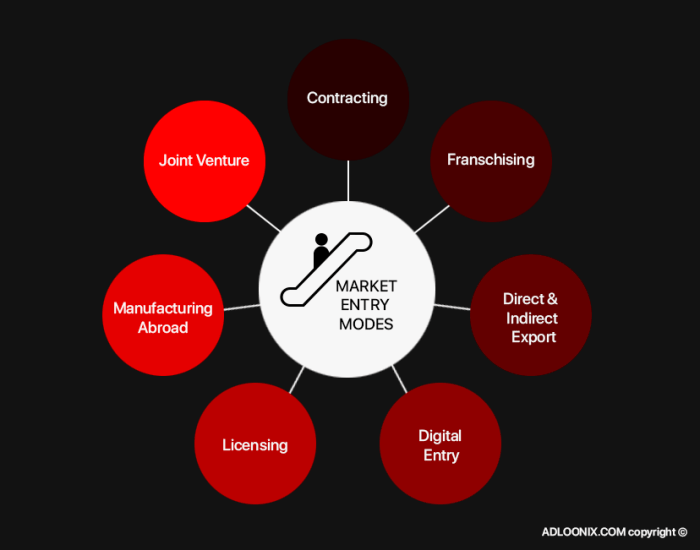Market Entry Strategies: Paving Your Path to Success kicks off with a bang, diving deep into the world of market entry strategies and setting the stage for an enlightening journey filled with twists and turns.
As we delve further, you’ll uncover the key concepts, strategies, and considerations essential for making a mark in new markets.
Overview of Market Entry Strategies

When it comes to conquering new markets, you gotta have a solid game plan. That’s where market entry strategies come in, helping businesses navigate the waters of unfamiliar territories and maximize their chances of success.
Types of Market Entry Strategies
- Exporting: Selling products or services to a foreign market without any physical presence in that market. It’s like making moves from a distance, you know?
- Licensing: Allowing a foreign entity to use your intellectual property in exchange for royalties. It’s like lending your cool factor to someone else for a fee.
- Franchising: Granting another party the right to use your brand and business model in exchange for fees and royalties. It’s like expanding your squad with some new members.
- Joint Ventures: Partnering up with a local company in the target market to share resources and risks. It’s like teaming up to take on a big challenge together.
- Direct Investment: Setting up a physical presence in a foreign market through wholly-owned subsidiaries or facilities. It’s like planting your flag in a new territory and claiming it as your own.
Importance of Choosing the Right Market Entry Strategy
Choosing the right market entry strategy is crucial for the success of your business in a new market. It can determine how well you adapt to the local environment, how effectively you reach your target customers, and how efficiently you use your resources. It’s like picking the right weapon for a battle – it can make all the difference between victory and defeat.
Market Research
Market research plays a crucial role in developing effective market entry strategies. It provides valuable insights into the target market, competition, and consumer behavior, helping businesses make informed decisions.
Identifying Target Markets and Competition
Market research helps in identifying the most lucrative target markets for a company’s products or services. By analyzing demographics, psychographics, and buying behavior, businesses can pinpoint the specific segments that offer the highest potential for success. Additionally, thorough market research allows companies to assess the competitive landscape, understand key competitors, and identify unique selling propositions to differentiate themselves in the market.
- Conducting competitor analysis to understand strengths, weaknesses, opportunities, and threats.
- Surveying target customers to gather feedback on preferences, pain points, and unmet needs.
- Utilizing secondary research sources such as industry reports, market data, and trend analysis.
- Utilizing primary research methods like focus groups, interviews, and surveys to gather firsthand insights.
Entry Mode Selection

When entering a new market, companies have various options to choose from in terms of the mode of entry. Each mode offers its own set of advantages and disadvantages, which can impact the success of the market entry strategy. Let’s take a look at some common entry modes and compare them to see which one might be the most suitable for a particular situation.
Exporting
Exporting involves selling products or services produced in one country to another country. This can be done through direct exporting, where the company handles distribution, or indirect exporting, where intermediaries are used.
- Advantages:
- Low investment costs
- Quick entry into the market
- Allows for testing of the market
- Disadvantages:
- Limited control over marketing and distribution
- Dependence on intermediaries
- Potential for trade barriers
Licensing
Licensing involves granting permission to a foreign company to produce and sell the licensor’s products or use their intellectual property in exchange for royalties or fees.
- Advantages:
- Low investment and risk
- Access to local market knowledge and distribution channels
- Potential for rapid market expansion
- Disadvantages:
- Loss of control over product quality and brand image
- Dependence on licensee’s capabilities
- Risk of intellectual property infringement
Joint Ventures
Joint ventures involve forming a partnership with a local company to establish a new entity or collaborate on a specific project.
- Advantages:
- Shared investment costs and risks
- Access to local expertise and resources
- Ability to navigate legal and cultural barriers
- Disadvantages:
- Potential for conflicts over decision-making
- Shared profits and control
- Risk of knowledge transfer to the partner
Examples of Successful Market Entry Strategies
One notable example of a successful market entry strategy using different entry modes is Starbucks. The company initially started with licensing agreements in international markets to leverage local expertise and resources. As Starbucks expanded further, it also utilized joint ventures with local partners to navigate complex regulatory environments and cultural differences. This hybrid approach to market entry allowed Starbucks to establish a strong global presence while adapting to local market conditions effectively.
Cultural Considerations: Market Entry Strategies
When expanding into international markets, understanding cultural differences is crucial for the success of market entry strategies. Cultural considerations play a significant role in shaping consumer behavior, preferences, and expectations, which can greatly impact the effectiveness of business operations in a new market.
The Importance of Cultural Understanding, Market Entry Strategies
- Cultural norms and values: Different cultures have unique norms and values that influence consumer behavior and perceptions of products or services. It is essential to align marketing strategies with these cultural aspects to resonate with the target audience.
- Communication styles: Language barriers, non-verbal cues, and communication etiquette vary across cultures. Adapting communication strategies to suit the cultural context can help build trust and establish strong relationships with stakeholders.
- Consumer preferences: Cultural factors such as dietary habits, fashion trends, and lifestyle choices can impact product acceptance and demand. Tailoring products and services to meet the specific needs of the target market is crucial for market penetration.
Adapting Market Entry Approaches
- Localization strategy: Customizing marketing campaigns, product features, and pricing to suit the cultural preferences of the target market can enhance brand perception and customer loyalty.
- Cultural training: Providing cultural sensitivity training to employees involved in the market entry process can help avoid misunderstandings and foster positive relationships with local partners and customers.
- Partnerships and collaborations: Forming strategic alliances with local businesses or influencers who understand the cultural landscape can provide valuable insights and support successful market entry.



